SSZT961 september 2017 LMZ31710 , TPSM84A21 , TPSM84A22
The ideal goal of a DC/DC step-down (buck) point-of-load power module is to integrate the entire bill of materials (BOM) inside the package. In reality, most power modules require several external components, including input and output capacitors. These capacitors are usually external because they are too expensive and bulky to integrate in the package.
A high-switching-frequency buck architecture will minimize both the size and amount of external capacitors. But while these architectures shrink the BOM to enable integration in the module, you will have to make trade-offs in performance and operating range.
Take for example the TPSM84A21, a 10A DC/DC power module that uses a high-frequency two-phase architecture and switches at 4MHz. The TPSM84A21 integrates 66.1µF of input capacitance and 185µF of output capacitance, a regulator IC, two inductors, and passives in a 9mm-by-15mm-by-2.3mm package. The only external component required is a single programming resistor. For comparison, the LMZ31710 is a 10A DC/DC power module in a 10mm-by-10mm-by-4.3mm package that switches at 500kHz and requires significantly more capacitance than the TPSM84A21, all external to the module. Table 1 compares the capacitance.
| TPSM84A21 | LMZ31710 | |
|---|---|---|
| Input capacitance | Internal: 66.1µF ceramic | External: 100µF tantalum 47.1µ ceramic |
| Output capacitance | Internal: 185µF | External: 200µF tantalum 220µF ceramic |
Let’s take a further look at how these two solutions compare in specs, solution size, efficiency, transient response and electromagnetic interference (EMI) performance.
Spec and Feature Comparison
| TPSM84A21 | LMZ31710 | |
|---|---|---|
| Minimum input voltage (V) | 8V | 4.5V (2.95V with external bias) |
| Maximum input voltage (V) | 14V | 17V |
| Minimum output voltage (V) | 0.55V 1.2V (TPSM84A22) | 0.6V |
| Maximum output voltage (V) | 1.35V 2.05V (TPSM84A22) | 3.6V |
| Maximum output current (A) | 10A | 10A |
| Typical switching frequency | 4MHz | 500kHz |
| Power good | Y | Y |
| Adjustable soft start | N | Y |
| Current sharing | N | Y |
| Adjustable current limit | Y | Y |
| Frequency synchronous input | Y | Y |
| Frequency synchronous output | N | Y |
Solution Size
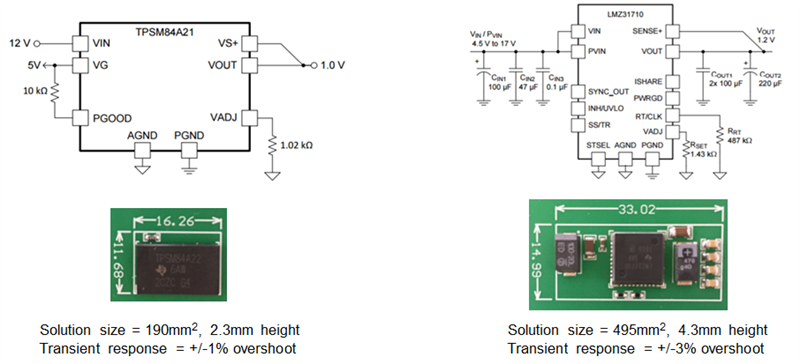 Figure 1 Solution-size Comparison
Figure 1 Solution-size ComparisonEfficiency
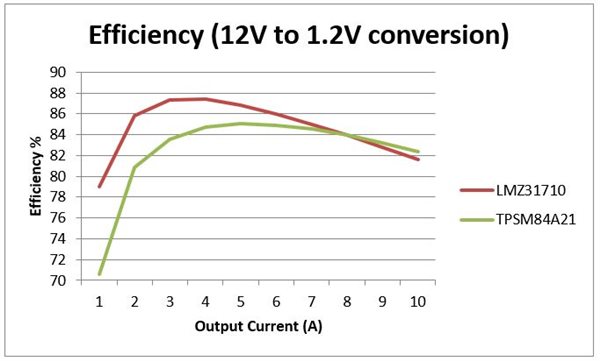 Figure 2 Efficiency Comparison for a
12V-to-1.2V Conversion
Figure 2 Efficiency Comparison for a
12V-to-1.2V ConversionFigure 3 shows how the efficiency of the TPSM84A22 and LMZ31710 are similar for a 12V-to-1.8V conversion.
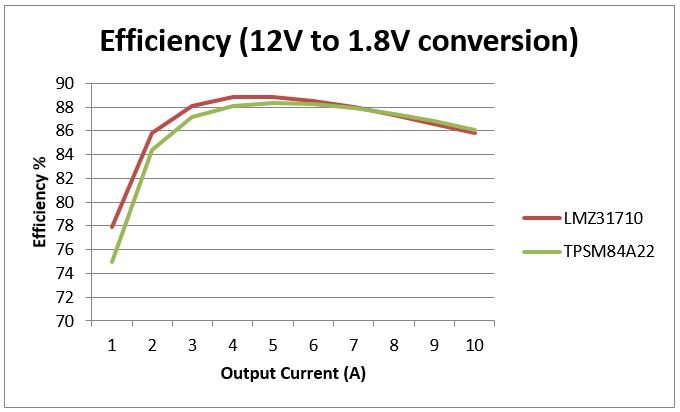 Figure 3 Efficiency Comparison for a
12V-to-1.8V Conversion
Figure 3 Efficiency Comparison for a
12V-to-1.8V ConversionTransient Response
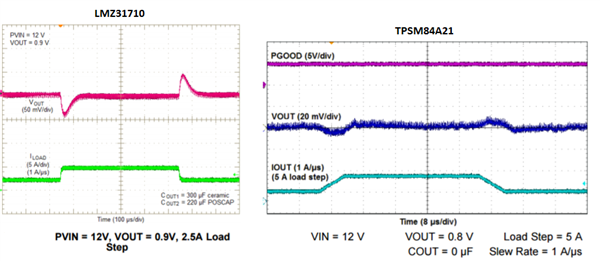 Figure 4 Transient Response Comparison
Figure 4 Transient Response ComparisonRadiated EMI
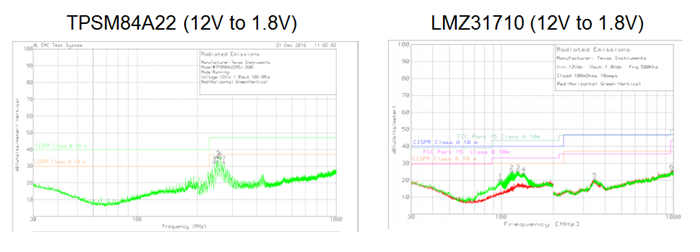 Figure 5 Radiated EMI
Comparison
Figure 5 Radiated EMI
ComparisonConclusion
Additional Resources
- Read the blog post, “Step by step: How the series capacitor buck converter works.”
- Start a design now with WEBENCH® power designer.
- Order the TPSM84A21 10A SWIFT™ power module evaluation module.